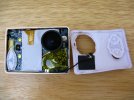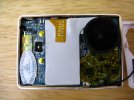Nigel
Well-Known Member
- Joined
- Jul 7, 2014
- Messages
- 16,748
- Reaction score
- 8,740
- Location
- Wales
- Country
- United Kingdom
- Dash Cam
- Gitup F1+G3ꞈꞈꞈꞈꞈ Viofo A229ꞈꞈꞈꞈꞈ Blueskysea B4K
I'm not sure, 29 degrees C is not excessive, it is less than blood temperature, in some places it is quite cool for summer temperatures!Not likely, right?
Also their response says that it shuts down if too hot, and even if it doesn't the power spec is for only 1A max, which is only 5 watts which isn't all that much heat, especially for a metal case.
It's not even a black front that would have absorbed the heat of the sun, being silver it should have reflected the sun's heat!
Most likely they have used some very low temperature plastic for the front panel and they are all like that. Their other cameras, like the SJ6 have a rubbery plastic so maybe they don't have experience with the stuff they used on the SJ7 and didn't think of testing it before launch.


